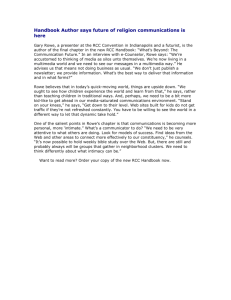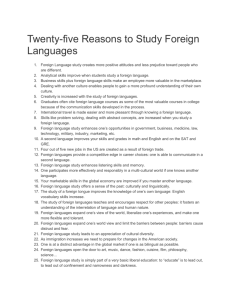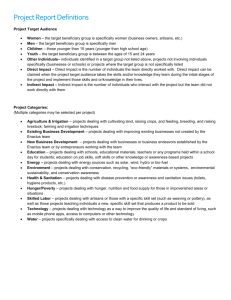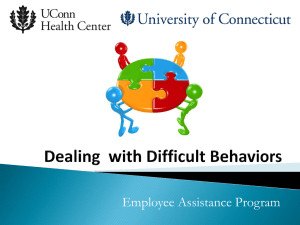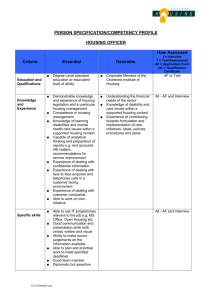Organizational Systems For Dealing With Conflict & Learning From
advertisement
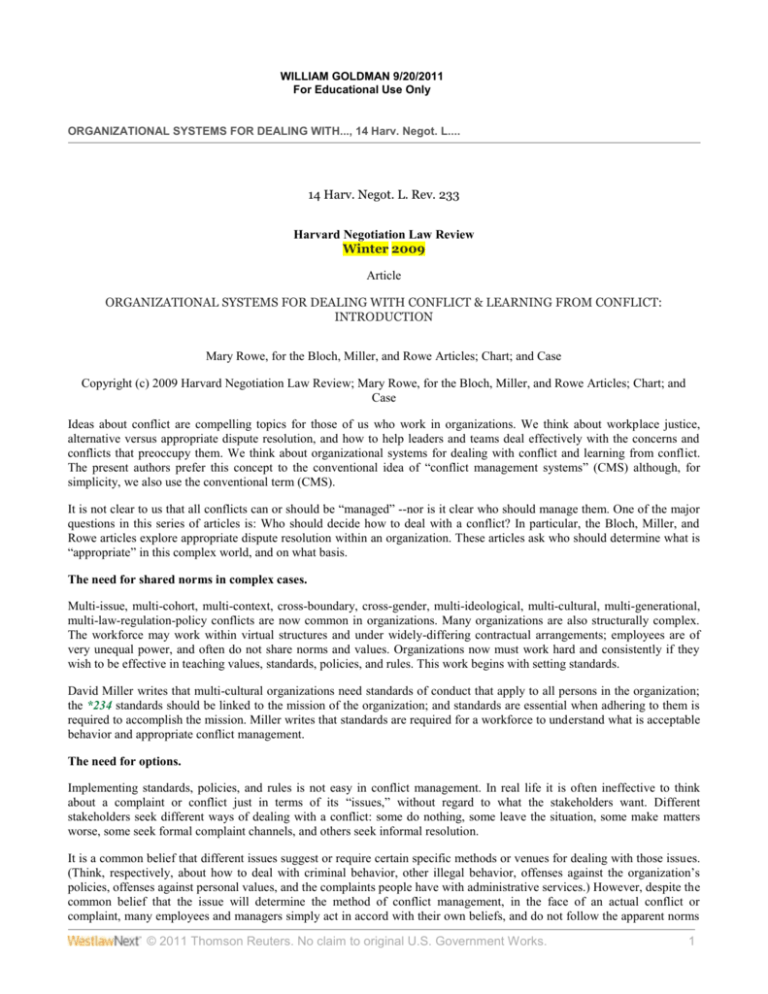
WILLIAM GOLDMAN 9/20/2011 For Educational Use Only ORGANIZATIONAL SYSTEMS FOR DEALING WITH..., 14 Harv. Negot. L.... 14 Harv. Negot. L. Rev. 233 Harvard Negotiation Law Review Winter 2009 Article ORGANIZATIONAL SYSTEMS FOR DEALING WITH CONFLICT & LEARNING FROM CONFLICT: INTRODUCTION Mary Rowe, for the Bloch, Miller, and Rowe Articles; Chart; and Case Copyright (c) 2009 Harvard Negotiation Law Review; Mary Rowe, for the Bloch, Miller, and Rowe Articles; Chart; and Case Ideas about conflict are compelling topics for those of us who work in organizations. We think about workplace justice, alternative versus appropriate dispute resolution, and how to help leaders and teams deal effectively with the concerns and conflicts that preoccupy them. We think about organizational systems for dealing with conflict and learning from conflict. The present authors prefer this concept to the conventional idea of “conflict management systems” (CMS) although, for simplicity, we also use the conventional term (CMS). It is not clear to us that all conflicts can or should be “managed” --nor is it clear who should manage them. One of the major questions in this series of articles is: Who should decide how to deal with a conflict? In particular, the Bloch, Miller, and Rowe articles explore appropriate dispute resolution within an organization. These articles ask who should determine what is “appropriate” in this complex world, and on what basis. The need for shared norms in complex cases. Multi-issue, multi-cohort, multi-context, cross-boundary, cross-gender, multi-ideological, multi-cultural, multi-generational, multi-law-regulation-policy conflicts are now common in organizations. Many organizations are also structurally complex. The workforce may work within virtual structures and under widely-differing contractual arrangements; employees are of very unequal power, and often do not share norms and values. Organizations now must work hard and consistently if they wish to be effective in teaching values, standards, policies, and rules. This work begins with setting standards. David Miller writes that multi-cultural organizations need standards of conduct that apply to all persons in the organization; the *234 standards should be linked to the mission of the organization; and standards are essential when adhering to them is required to accomplish the mission. Miller writes that standards are required for a workforce to understand what is acceptable behavior and appropriate conflict management. The need for options. Implementing standards, policies, and rules is not easy in conflict management. In real life it is often ineffective to think about a complaint or conflict just in terms of its “issues,” without regard to what the stakeholders want. Different stakeholders seek different ways of dealing with a conflict: some do nothing, some leave the situation, some make matters worse, some seek formal complaint channels, and others seek informal resolution. It is a common belief that different issues suggest or require certain specific methods or venues for dealing with those issues. (Think, respectively, about how to deal with criminal behavior, other illegal behavior, offenses against the organization’s policies, offenses against personal values, and the complaints people have with administrative services.) However, despite the common belief that the issue will determine the method of conflict management, in the face of an actual conflict or complaint, many employees and managers simply act in accord with their own beliefs, and do not follow the apparent norms © 2011 Thomson Reuters. No claim to original U.S. Government Works. 1 WILLIAM GOLDMAN 9/20/2011 For Educational Use Only ORGANIZATIONAL SYSTEMS FOR DEALING WITH..., 14 Harv. Negot. L.... about how a given issue should be addressed. In reality, there is no single, effective way to decide which problems should go to which conflict management options, because people so often vote with their feet. Both managers and disputants often (1) ignore a complaint or conflict, or (2) think they alone own it and (3) may want to deal with it in ways that are different from the approaches other stakeholders might take. New laws and standards, combined with very diverse values held by people in conflict have, therefore, led to the need for options in conflict resolution and complaint handling. Providing a variety of options in turn suggests the need for a systems approach. A relatively simple way to think about conflict management options within a system is to define them in terms of dealing with conflict on the basis of interests, rights, and power (please see accompanying Chart). In reality, of course, interests, rights, and power overlap to some extent within almost all options. And, in reality, all conflict management offices use some interest-based, rights-based, and power-based ideas to deal with problems. However, for *235 simplicity, we will use these rubrics in discussing elements of conflict management systems. So, different issues and differing values lead to the need for options, and having options suggests building a system. As it happens, it is not a simple thing to develop a coherent system. There is a fundamental issue about “who owns” a conflict or a complaint. Who has the right to choose which option or options to use? As a first example, a multi-issue, multi-cohort case may present a problem within a systems approach. A given case may seem relevant to many different offices and functions on the accompanying Chart. Each office might think it should “own” the case, because it appears to “own” one or another of the many issues in the case, and it provides one or more functions relevant to the case. As a second example, suppose the individuals engaged in conflict do not take the problems to any manager or office on our Chart. Conflict managers and dispute system designers sometimes talk as if “all” disputes will, actually, surface within the system. In real life most concerns and conflicts most of the time are addressed by the individuals involved or these parties suffer in silence. Resolution by the parties involved may often be a good thing--think, for example, of a well-functioning team. However, does this mean that in real life individuals are part of a “conflict management system?” What are the implications for system design? Design and implementation. In his paper, Brian Bloch illustrates the process of designing and building a system that enables people to “learn the art of dealing with conflict.” He records how he added interest- and rights-based options to an organization that previously did not provide those options, in order to meet the needs of individuals and groups. Bloch, Miller, and Rowe all wryly attest to the fact that this process is often less than elegant and that there is much to learn. Conflict management systems “happen,” however much we try to design them. As it turns out, taking a “true” systems approach to dealing with conflict within an organization is difficult, for many theoretical and practical reasons. These articles outline some problems in conflict management systems design: • Conflict management systems are difficult for managers and employees to understand. Different managers often feel naturally attuned to one or another option in the system, but various *236 disputants may be drawn to other options. Added to this confusion is the fact that most employees and managers do not understand all the relevant policies and procedures--let alone how each option in the system actually works. Sometimes it is not even obvious which offices would be considered part of a given CMS. • A system must try to balance the rights and interests of the organization, of its different conflict management offices, and of all the individuals involved in a conflict. These needs are sometimes at odds with each other. (A classic dilemma of this kind is illustrated in the accompanying Case.) Mary Rowe discusses the important contributions that an organizational ombudsman--a zero barrier office--offers in dealing © 2011 Thomson Reuters. No claim to original U.S. Government Works. 2 WILLIAM GOLDMAN 9/20/2011 For Educational Use Only ORGANIZATIONAL SYSTEMS FOR DEALING WITH..., 14 Harv. Negot. L.... with major dilemmas of systems that are meant to deal with conflict and learn from conflict. Indeed, the key role of the organizational ombudsman1 is discussed in all three of these articles on conflict management systems design. TABULAR OR GRAPHIC MATERIAL SET FORTH AT THIS POINT IS NOT DISPLAYABLE Footnotes 1 The International Ombudsman Association provides the Code of Ethics and Standards of Practice for an organizational ombudsman. See IOA Code of Ethics (2007), available at http://www.ombudsassociation.org/standards/; IOA Standards of Practice (2007), available at http:// www.ombudsassociation.org/standards/. In these articles, we use the term “ombudsman” for the practitioner and “Ombuds Office” for the office. Like our professional association, the IOA, we respect the use of various forms of these terms. End of Document © 2011 Thomson Reuters. No claim to original U.S. Government Works. © 2011 Thomson Reuters. No claim to original U.S. Government Works. 3


